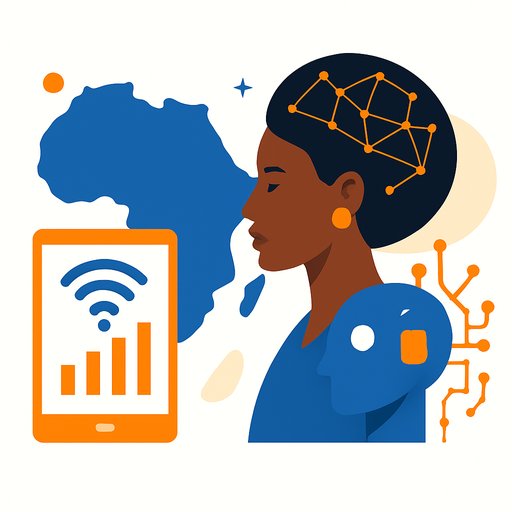From Digitization to Agentic AI: The Next Decade of African Enterprise
Over the past decade, Africa made a clear leap in digital finance. Mobile money, led by M-Pesa, helped lift financial inclusion from 23 per cent in 2007 to over 60 per cent across Sub-Saharan Africa, pulling millions into formal markets.
That phase focused on efficiency. We took existing processes, put them on mobile rails, and removed friction. The next phase is different: agentic AI-systems that can sense context, make decisions, and take actions across your tech stack with defined goals and guardrails.
What agentic AI means in practice
Think beyond dashboards and basic automation. Agentic systems plan multi-step tasks, call tools and APIs, coordinate with other agents, learn from outcomes, and escalate to humans when needed.
For executives, this turns static workflows into living systems. It changes how you allocate capital, design teams, and compete.
Why this matters for African enterprises
- Margin pressure: Agents can reduce cycle times in underwriting, collections, routing, and support without large headcount growth.
- Access at scale: Mobile-first agents meet customers on USSD, WhatsApp, and voice, in local languages, across fragmented connectivity.
- Resilience: Event-driven agents can react to network outages, weather, and supply volatility with real-time decision loops.
High-value use cases to prioritize
- Financial services: Micro-underwriting using mobile money histories, alt-data, and geospatial signals; agent-led collections with dynamic outreach and settlement offers.
- Telecom and FMCG: Agent-managed field force scheduling, stockout prevention, and agent network support via chat and voice.
- Logistics: Automated dispatch, route re-optimization, and exception handling tied to fuel, traffic, and weather events.
- Agriculture: Input financing, crop advisory, and claim triage using satellite weather, soil data, and local pricing feeds.
- Customer service: Tier-1 resolution across WhatsApp and voice with seamless human handoff and post-resolution follow-up.
Operating model shifts
- From owners to orchestrators: Product and operations leaders define goals, constraints, KPIs; agents execute.
- Human-in-the-loop: Set clear thresholds for review on risk, spend, and compliance. Keep final accountability with humans.
- AI PMO: Establish a small central team for standards, tooling, risk, and shared services. Delivery stays with business lines.
Technical foundations (keep it pragmatic)
- Data layer: Clean event streams from core systems; minimal but reliable features; clear data lineage.
- Tooling access: Secure APIs to CRM, ERP, payments, messaging, and logistics. Start with read-only, then expand to write actions.
- Orchestration: A queue or workflow engine that supports retries, timeouts, and audit trails.
- Memory: Use lightweight vector or key-value stores for context. Keep PII encrypted and scoped.
- Interfaces: USSD, WhatsApp, SMS, and voice gateways for reach across device types and bandwidth.
Risk, controls, and compliance
- Guardrails first: Define allowed actions, spending caps, rate limits, and approval tiers per agent.
- Auditability: Log prompts, data inputs, tool calls, and outputs with timestamps and IDs.
- Fairness and bias: Test outcomes by segment; avoid proxy variables that replicate historical bias.
- Privacy and data residency: Follow sector rules; minimize personal data exposure to external models.
- Incident response: Create kill switches, rollback plans, and clear on-call coverage.
A 90-day plan for executives
- Weeks 1-2: Identify 3 processes with high volume, clear rules, and measurable outcomes (e.g., debt collection outreach, ticket triage, delivery routing).
- Weeks 3-4: Map decisions, tools, and guardrails. Define success metrics: cycle time, cost per ticket, default rate, first-contact resolution.
- Weeks 5-8: Build a thin slice. Read-only first. Then enable one safe write action under approvals.
- Weeks 9-10: Run an A/B or phased rollout. Compare performance across cohorts.
- Weeks 11-12: Review risk events, refine constraints, and plan scale or sunset based on ROI.
Metrics that matter
- Speed: Cycle time per process, lead time to decision, time-to-resolution.
- Quality: Error rate, escalation rate, customer satisfaction (NPS/CSAT), complaint volume.
- Financials: Cost per outcome, recovery rate, churn, on-time-in-full, revenue per rep.
- Risk: Policy violations, override rate, data exposure incidents.
Africa-specific execution notes
- Connectivity variance: Build for offline and low-bandwidth paths; queue actions and sync later.
- Channel mix: Prioritize USSD, WhatsApp, and voice alongside apps and web.
- Languages: Support local languages with clear fallback to human agents.
- Partnerships: Work with MNOs and agent networks for reach and trusted distribution.
- Data sources: Mobile money logs, transaction alerts, geospatial data, and public records-used with consent and care.
Context and references
Mobile money set the stage for what's next in AI-driven operations and services. For background on financial inclusion and mobile money growth, see the World Bank's Global Findex and GSMA's industry reports.
Where to upskill your teams
Treat agentic AI as a capability that blends product, ops, data, and risk. Start small, measure hard, and scale what works.
If you need structured paths by role and function, explore AI courses by job for practical, execution-focused learning.
Your membership also unlocks:






